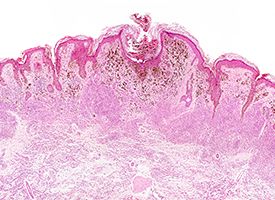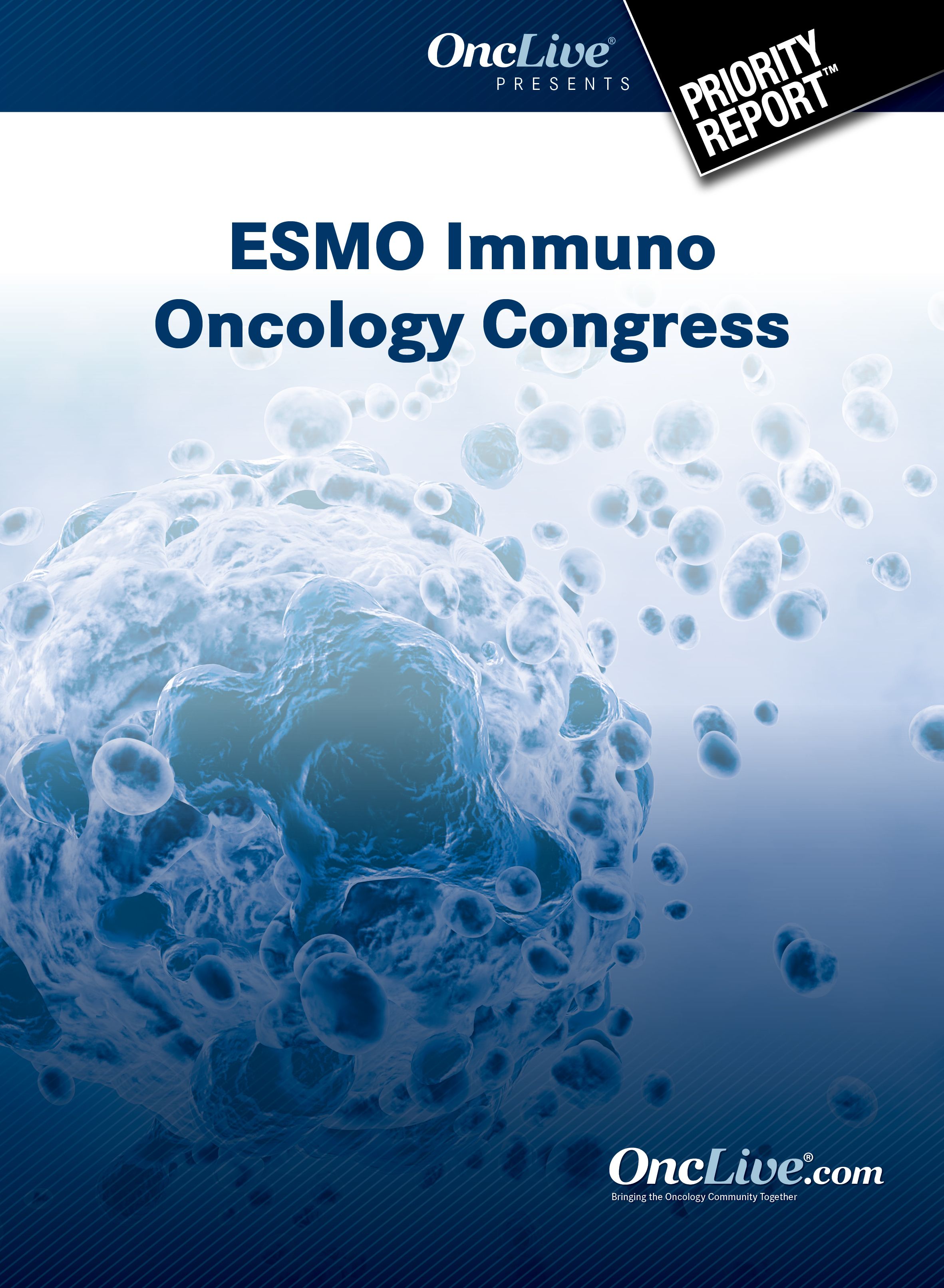Publication
Article
Prolgolimab Shows Promise in Advanced Melanoma
Author(s):
Patients with unresectable or metastatic melanoma showed durable responses following treatment with the novel PD-1 inhibitor prolgolimab.

Patients with unresectable or metastatic melanoma showed durable responses following treatment with the novel PD-1 inhibitor prolgolimab, according to the final analysis of the phase II MIRACULUM trial (NCT03269565) presented at the 2019 ESMO Immuno-Oncology Congress. The study, which tested 2 dosing strategies of prolgolimab, met the primary efficacy endpoint in both treatment arms. In arm 1, 63 patients were treated with prolgolimab at 1 mg/kg every 2 weeks and 63 patients in arm 2 received prolgolimab at 3 mg/kg every 3 weeks until disease progression or intolerable toxicity.
In patients who had ≥1 dose of prolgolimab and had CT scans, the objective response rate (ORR) was 40.7% in arm 1, comprising 5 (8.5%) complete responses (CRs) and 19 (32.2%) partial responses (PRs). In arm 2, in which patients received a higher dose at less frequent intervals, the ORR was 32.7% (n = 18), which included 2 (3.64%) CRs and 16 (29.09%) PRs.
“Both dosing regimens of prolgolimab have durable antitumor activity in patients with advanced melanoma,” said Sergey Tjulandin MD, DSCi, deputy director and head of Department of Clinical Pharmacology and Chemotherapy of the N.N. Blokhin Cancer Research Center of Oncology in Moscow, Russia.
Prolgolimab is an IgG1 PD-1 monoclonal antibody with a L234A-L235A (LALA) mutation that results in silencing of Fc binding, according to Tjulandin.
“Prolgolimab binds to PD-1 with high affinity and specificity; it lacks antibody-dependent cellular toxicity and complement-dependent cytotoxicity, which can induce macrophage-mediated killing of effector T cells,” Tjulandin explained.
In the multicenter, open-label, parallel-arm, phase II MIRACULUM investigators evaluated the antitumor activity of prolgolimab in patients with advanced melanoma.
A total of 126 patients, all of whom were included in the efficacy and safety analysis, were randomized into the study and received ≥1 dose of prolgolimab (mITT population). At a median follow-up of 13.8 months in arm 1 and 14.5 months in arm 2, 59 and 55 patients in the respective arms had received ≥1 dose of prolgolimab and underwent ≥1 scheduled CT scan and were included in the per protocol (PP) population.
To be eligible for enrollment, patients with unresectable or metastatic melanoma had no underlying autoimmune disease, and had not received prior treatment with BRAF/MEK inhibitors, PD-1 inhibitors, or CTLA-4 inhibitors. Patients were randomized to 1 of the 2 dosing strategies.
The primary endpoint was ORR, according to irRECIST criteria. Secondary endpoints were progression-free survival (PFS), overall survival (OS), disease control rate (DCR), time to response, and duration of response.
Baseline patient characteristics were generally balanced between the 2 arms; in arms 1 and 2, 17 versus 16 patients had received prior chemotherapy and 4 (6.4%) versus 2 (3.2%) patients had stage II to III unresectable disease, respectively. The majority (93.7% in arm 1 and 96.8% in arm 2) of patients had metastatic melanoma, and central nervous system metastases were present in 27.0% and 14.3% of patients, respectively. PD-L1 expression was detected in 52.4% of patients on arm 1 and 49.2% of patients on arm 2.
Results of the PP population also showed that, in arm 1, 16 (27.1%) patients achieved stable disease (SD) for a DCR of 67.8%. In arm 2, SD was observed in 11 (20.0%) patients for a DCR of 52.7%.
The median duration of response was not reached as of the data cutoff, with 83% of responding patients maintaining response. The median time to response was 3.65 months (95% CI, 1.84-3.98) in arm 1 and 3.68 months (95% CI, 1.84-5.55) in arm 2.
In the overall mITT population, which included all patients regardless of whether they had received CT scans, the ORR was 38.1%, which included 5 (7.9%) CRs and 19 (30.2%) PRs in arm 1. Sixteen (25.4%) patients had SD and the DCR was 63.5%. In arm 2, the ORR was 28.6%, including 2 (3.2%) CRs and 16 (25.4%) PRs. SD was observed in 11 (17.5%) patients for a DCR of 46.0%.
PFS and OS were also calculated in the mITT population. In arm 1, the median PFS was 5.78 months (95% CI, 3.5—not reached) and the 12-month PFS rate was 41.3%. The median OS was not reached, and the 12 month-OS rate was 74.6%.
In arm 2, the median PFS was 2.33 months (95% CI, 2.07-10.25) and the 12-month PFS rate was 35.0%. Median OS was not reached and the 12 month-OS rate was 54.0%.
Additionally, pharmacokinetic data showed that the serum half-life of prolgolimab was approximately 14 days, “which is consistent with the endogenous IgG1 half-life,” Tjulandin said. Importantly, the analysis did not detect anti-prolgolimab antibodies in any of the 121 patients having assessable samples at screening and at 1 other sampling point.
Regarding safety, in arms 1 and 2, treatment-related adverse events (TRAEs) occurred in 55.6% and 54.0% of patients, respectively; of these, 12.7% and 3.2% were grade ≥3. Treatment-related serious AEs occurred at 3.2% and only in arm 1.
Immune-related AEs were reported in 36.5% and 34.9% in arms 1 and 2, with 7.9% and 1.6% in the respective arms being grade ≥3. The most frequently reported immune-related AEs in arms 1 and 2 included endocrine disorders (20.6% vs 25.4%), hypothyroidism (14.3% vs 12.7%), hyperthyroidism (15.9% vs 11.1%), rash (7.9% vs 1.6%), pneumonitis (3.2% vs 6.4%), and myositis occurred in 3.2% of patients in arm 1 only. There was 1 case (1.6%) of tumor hemorrhage in arm 1. Treatment discontinuation was reported for 4.8% of patients on arm 1 and 3.2% of those on arm 2. No deaths occurred in either treatment arm.
“Both dosing regimens of prolgolimab had a manageable safety profile in patients with advanced melanoma,” said Tjulandin, who remarked that both doses with be taken forward to phase III trials for further study.
Tjulandin S, Fedyanin M, Demidov L et al. Final results of phase II trial (MIRACULUM) of the novel PD-1 inhibitor prolgolimab in patients with advanced melanoma. Ann Oncol. 2019;30(suppl_11):xi33-xi47. doi: 10.1093/annonc/mdz451









